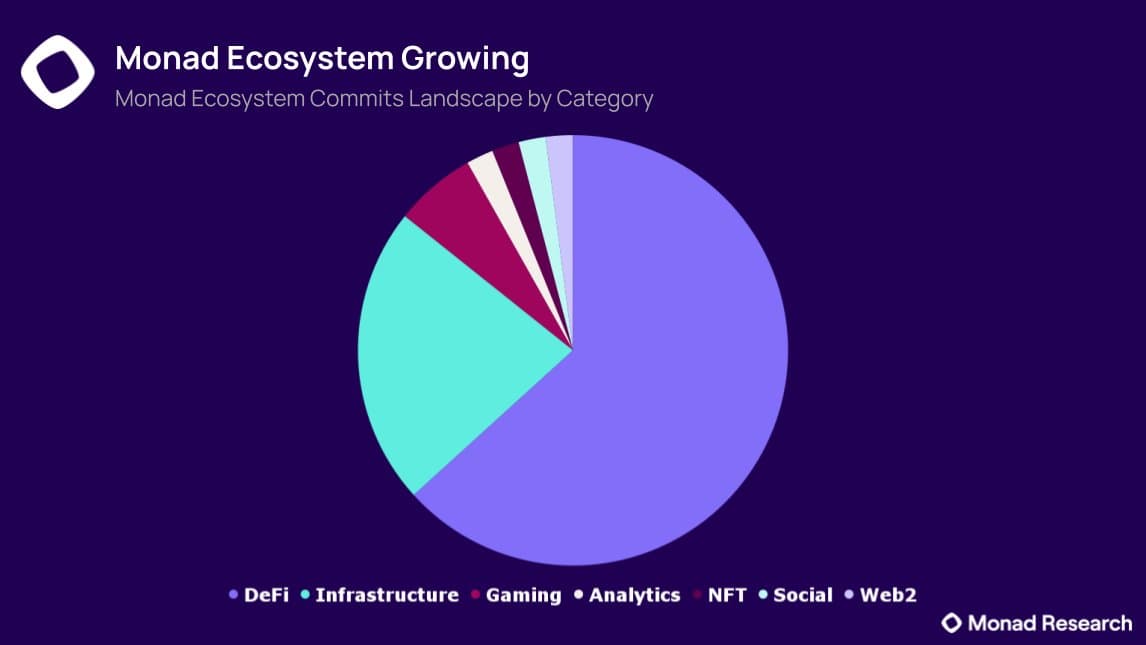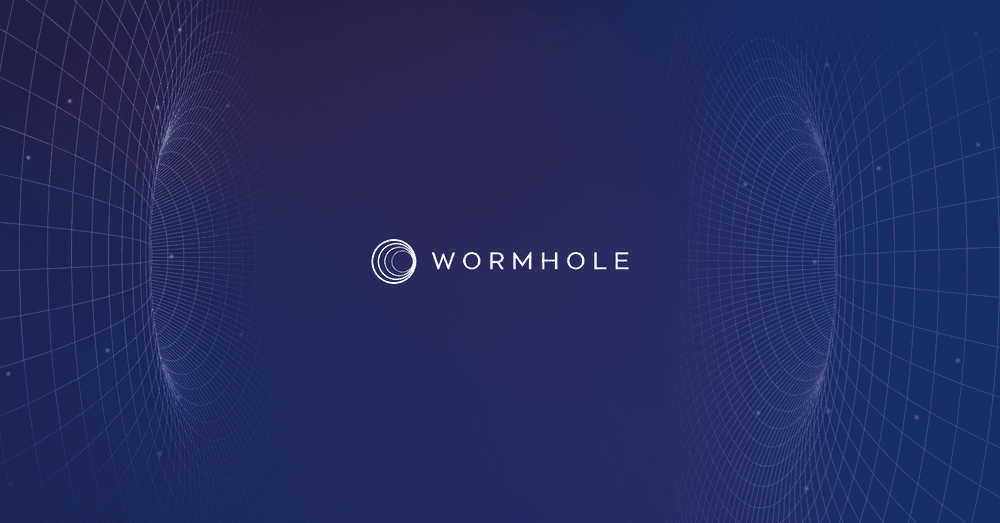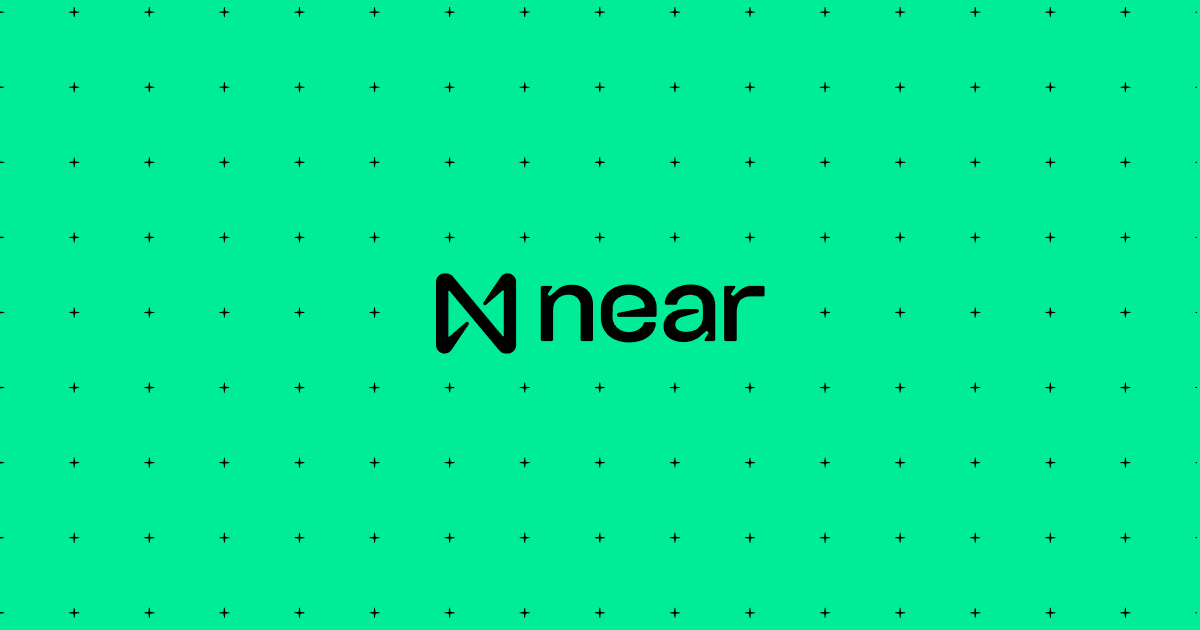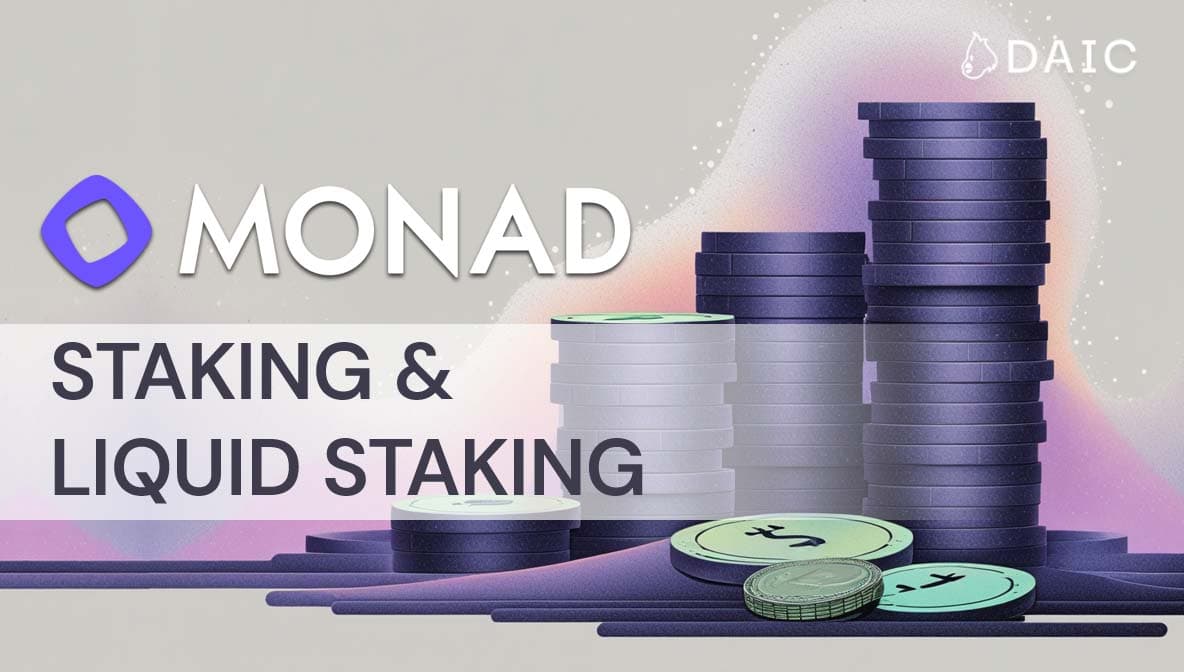Key Takeaways
- High Scalability: Monad aims to reach 10,000 transactions per second (TPS) initially, with potential for hundreds of thousands as the network matures.
- EVM Compatibility: Monad combines parallel execution with Ethereum compatibility, making it easier for developers to port projects.
- Partnerships: Collaborations with LayerZero, Pyth Network, and Wormhole enhance cross-chain interoperability.
- Growing Ecosystem: Over 80 projects are committed to building on Monad, with an expected increase as mainnet launches in late 2024.
- Competitors: Faces competition from Ethereum, Solana, and Aptos, which focus on scaling, low fees, and network stability.
Monad Ecosystem

Because the Monad blockchain has yet to launch on mainnet, its ecosystem is still developing. That said, as of February 2024 there are more than 80 independent protocols and dApps that have committed to building on the protocol. As mainnet launch draws nearer, this number is expected to be closer to 150 or 200.
One of the first large-scale players to integrate with Monad is LayerZero, an industry-leading protocol designed to enable cross-platform messaging and cross-chain interoperability among various chains and system types. LayerZero’s integration with Monad will allow for seamless interconnectivity with 50 to 60 (and growing) of the most reputable blockchains in the space.
In addition, the integration will allow data to be sent to and from Monad via a LayerZero endpoint for uses related to governance voting, contract calls for lending and borrowing, arbitrary data exchange, and more. The integration will also allow for the exchange of ERC-20 and native gas tokens as wrapped assets on Monad, while more LayerZero-connected utilities will be unveiled in the coming months

Of great significance, Monad also recently announced a partnership with Pyth Network. This will allow Pyth to use Monad’s highly scalable low-gas design to provide more reliable price feed data. Remember, more frequent price feed updates means more accurate data, and in turn, more efficient DeFi.
Some of the additional protocols building on the network include:
- Orderly Network - an omnichain liquidity layer and DEX frontend deployment platform
- Pike Finance a cross-chain lending and borrowing platform and decentralized money market
- Switchboard Oracles - a decentralized oracle network allowing for verifiable randomness, function, and price feeds
Additionally, Monad recently welcomed multiple other projects to the ecosystem, including Notifi Network (a notification and customer engagement infrastructure layer), Swaap Finance (a non-custodial interoperable market making infrastructure), Catalyst (an interoperability protocol and cross-chain AMM), Wombat Exchange (a multichain cross-chain single-sided DEX), TimeSwap Labs (an oracleless lending and borrowing protocol for the creation of ERC-20 money markets), and Aori (a high-performance orderbook protocol).
Furthermore, Dyson Finance (a DEX allowing retail investors to seamlessly provide liquidity), Ambient Finance (a DEX for diversified stable liquidity), AIT Protocol (an AI data platform employing the train-to-earn model), ACryptoS (a DEX, yield farming platform, and decentralized money market), and Monadians (an Monad-focused NFT collection) are among other projects that have partnered with Monad in recent months.
What’s more, Monad recently announced it would be integrating with the Wormhole cross-chain interoperability and bridging protocol to facilitate a robust connection with multiple blockchains such as Solana.

Roadmap and Future Initiatives
- February 2022 - Monad is founded in New York City
- February 2023 - Monad receives 19 million in funding from several leading crypto VC’s
- September 2023 - Monad docs are released, detailing the architecture of the Monad blockchain for the first time
- Second half of 2024 - Monad testnet launch
- Expected late 2025 - Monad mainnet launch
In the not-too-distant future, it seems likely that Monad will continue its focus on solving the issues that centralized and decentralized exchanges face by creating a platform scalable enough to deploy a decentralized limit order book exchange on top of its network.
Because the Monad protocol has yet to launch on mainnet, it is difficult to determine its exact roadmap moving forward. That said, the platform will likely launch its mainnet by the end of 2024, meaning its direction will be clearer at that time.

Comparative Analysis
Monad is a Layer 1 smart contract platform that is designed to be extremely scalable. In fact, many have hypothesized that it will become the most scalable platform to be released in the next 18 to 24 months, with tech rivaling industry giants such as Solana.
That said, an all-encompassing network as large as Solana exhibiting an extremely high total value locked (TVL), along with a massive user base, is quite another thing compared to a new platform like Monad that has yet to launch on mainnet. Make no mistake, once Monad launches it will surely grow its user base quickly, but it still has a long way to go in terms of real-world adoption.
One of the characteristics that separates Monad from many other blazing-fast chains is that it combines parallel execution (similarly to Aptos, Sui, Solana, and others) with EVM compatibility. Aptos, Sui, Solana and the like exhibit parallel execution, but are not Ethereum comptable, meaning it will be a continued challenge for developers on these networks to port their iterations from Ethereum.

Solana
By many accounts, Solana is the clear cut industry-leader in terms of speed and scalability, while being one of the most heavily used platforms in the blockchain arena. That said, many feel its design is quite centralized compared to Monad and others.
Solana makes use of a Proof of Stake (PoS)-based consensus mechanism called Tower BFT that leverages an enhanced version of Practical Byzantine Fault Tolerance (PBFT) while incorporating a clock-based timing mechanism called Proof of History (PoH) that decreases messaging overhead and latency.
The platform also utilizes Sealevel, a parallel execution framework focused on ensuring smart contracts work at hyper speed via a system that continuously modifies smart contracts when needed.
Solana is able to confirm blocks in 0.4 seconds and is scalable to 65,00 transactions per second (TPS), with transaction costs typically only fractions of a cent. In addition, Solana will soon launch Firedancer, a specialized validator set infrastructure that some believe will allow the network to process up to million TPS. This remains to be seen, however.
One of the biggest weaknesses of Solana is its lack of Ethereum Virtual Machine (EVM)-compatibility and the inability for developers to create Ethereum smart contracts in Solidity. While Solidity development on Solana is not possible, it is able to support Ethereum dApps through the Wormhole bridge. The fact remains though, that Monad has a significant advantage in this regard because of its fully-fledged EVM framework.

NEAR Protocol
NEAR Protocol is a Proof-of-Stake (PoS) blockchain conceptualized as a community-run cloud computing platform. NEAR utilizes sharding and other technological innovations to dramatically improve transaction throughput on the network.
Once its proprietary Nightshade sharding infrastructure is fully developed, NEAR claims to be able to process at least 100,000 transactions per second.
As a major competitor to Hedera Hashgraph, Monad, Avalanche, Solana, and others, NEAR defines its platform as an extremely fast, energy efficient, secure, and adaptable blockchain built for enterprise use and DeFi and a host of additional utilities.
To facilitate this functionality, NEAR helped construct Aurora, its EVM-compatible development framework, as well as its interoperability framework Octopus Network; and Rainbow Bridge as a means to send assets between Ethereum, Aurora, and NEAR. Despite its Aurora integration, NEAR is not Ethereum-compatible itself.
Similar to how MacOs, Windows, and Linux make computers simple to use, NEAR recently launched its Blockchain Operating System (BOS) as a framework that allows developers to build and use decentralized front-end applications on any blockchain network.
Despite these innovations, Monad employs pipelining in an EVM-compatible environment as opposed to NEAR, which does not. This technology alone could give Monad the potential to eventually outpace NEAR and others in terms of decentralization, network throughput, and scalability.
Other Highly Scalable Networks
Ethereum compatible chains hyper-focused on scalability include Avalanche, BNB Smart Chain, Fantom, Injective Protocol, and newcomers like Sei Network and Shardeum. Though, for the most part, it can be argued these chains do not exhibit the efficiencies that Monad presents in terms of scalability, decentralization, and EVM-compatibility.
Other blockchains that have claimed to be highly scalable include Ripple, Stellar, Algorand, Kadena, Aptos, Sui, MultiversX, and Cardano.
In addition, some have hypothesized that Ethereum could eventually process more than 100,000 TPS once its sharding capabilities are fully realized. That fact remains however, that this is still unproven and the sheer size of the network could make this very difficult to accomplish.
Many experts also feel that Etheruem’s infrastructure is older and very difficult to modify, meaning it cannot realistically keep up to the scalability of newer, more recently developed chains. Again, time will tell if the Ethereum network can overcome these challenges long-term.
Analyzing Monad’s Potential Moving Forward
Though quite new, Monad represents a blockchain that has very high long-term potential. Its combination of decentralization, extreme scalability, and Ethereum-compatibility is a game-changer in the blockchain space. Specifically, its parallel execution and superscalar pipelining frameworks and other cutting-edge innovations position Monad well technologically moving forward.
Monad’s ability to reach 10,000 TPS is an extremely strong benchmark compared to many currently existing chains. Because 10,000 transactions per second is a starting point for the network, Monad could theoretically scale to hundreds of thousands of TPS over the next several years.
That said, Monad faces an uphill battle in terms of adoption to gain significant market share among large competitors that are already established especially in its first year or two of development.
Conversely, the fact that the platform has already established strong foundational partnerships with the likes of LayerZero, Pyth Network, Wormhole, and others is a good sign that its 80-strong ecosystem will grow substantially over time, with an estimated 150 projects positioned to build on the platform at mainnet launch.
Nonetheless, the prevalence of so many large Layer 2 platforms launching on Ethereum in the first half of 2024 (combined with many existing Layer 2’s) could mean that many Layer 1 platforms struggle to gain adoption.
Regardless, it is quite clear that Monad has the potential to become an industry-changing blockchain for the creation of decentralized high-performance exchange platforms, trading systems, and a variety of utilities moving forward.
Resources
The information provided by DAIC, including but not limited to research, analysis, data, or other content, is offered solely for informational purposes and does not constitute investment advice, financial advice, trading advice, or any other type of advice. DAIC does not recommend the purchase, sale, or holding of any cryptocurrency or other investment.


